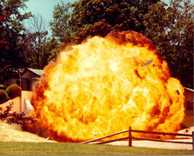Mining Feature: Coal Mine Explosion Prevention
Friday, December 09, 2011
There are two main types of coalmine explosions: methane and coal dust. Methane explosions occur when a buildup of methane gas contacts a heat source and there is not enough air to dilute the gas level below its explosion point. Likewise, fine particles of coal dust in the right concentration that contact a source of heat can also be explosive. Hybrid explosions consisting of a combination of methane and coal dust can also occur.
Where does the methane in a coal mine come from?
Methane is formed as a byproduct of the coal formation. The methane that is adsorbed in the coal is released as the coal is mined or it migrates from surrounding sources above or below the coal seam through fractures created by the coal extraction process.
How is methane detected and controlled?
Large fans circulate air in mines to provide ventilation to the working areas. These fans operate to dilute the methane to well below explosive levels (5-15%). Monitors installed on mining machines deactivate the machine when the methane concentration reaches 1%. Mines with excessive methane can remove the gas prior to mining by drilling drainage holes.
What is done to suppress face ignitions?
A common cause of methane face ignitions is the spark or hot streak created when cutting roof or floor rock with the mining machine. Applying directed water sprays behind the cutting bit to cool and limit the size of the hot streak can prevent these frictional ignitions.
How Big is the Problem?
- From 1986 to 2010, there were 10 multiple fatality explosions in underground coal mines in the U.S.
- These explosions increased the fatality rate from 44.0 to 81.3 in 2006 and from 23.5 to 80.4 in 2010 (per 100,000 employee hours worked, underground coal).
- The worst disaster caused by a coal mine explosion in the U.S. occurred in 1907 when 362 miners were killed in Monongah, WV.
How is methane controlled from mined-out areas?
Coal mines generally have active mining zones and areas that were previously mined. These mined-out areas can be abandoned areas that are no longer ventilated and are separated from the active mining areas by explosion-resistant structures called seals. Seals are designed to contain an explosion within the abandoned area. Longwall mining is an example in which an "active" mined-out area called a "gob" is created behind the advancing panel extraction. This gob area becomes a reservoir for methane gas to collect, and may be difficult to fully ventilate because the overburden has collapsed and filled this area full of broken rock fragments. In this case, ventilation of the working face is critical to restrict the migration of methane from the gob and dilute that which escapes into the working area.
Why do coal dust explosions tend to be more extensive than methane explosions?
Methane is more readily ignitable than coal dust. In most cases, dust explosions are first initiated by methane explosions. The pressure wave or wind forces created by a small methane explosion can scour the mine entry, blowing coal dust up into the air. Once this dust is ignited, a chain reaction effect can occur and flame propagation can continue to spread over long distances consuming available fuel and oxygen and generating large volumes of toxic gases. Under constricting conditions such as blockage or restriction of the airway, both methane and coal dust explosions have the potential to accelerate and transition into the most severe situation, called a detonation.
What is done to prevent coal dust explosions?
Underground coal mining produces finely divided coal dust that deposits throughout the mine and serves as a source of combustible material for coal dust explosions. Limestone powder, known as rock dust, is spread throughout the mine workings on a regular basis. This rock dust serves to inert the coal dust when applied in the proper proportion. When explosions do occur, the dispersed limestone powder absorbs the heat generated from the explosion and will either stop the chain reaction or reduce the intensity of the explosion. It is critical that this inertization practice of rock dusting be consistent with the mining process. Even a thin layer of additional coal dust deposited on a previously rock dusted area can restore the explosive condition.
Want to find out more about the NIOSH research to prevent coal mine explosions?
Prevention of coal mine explosions requires a suite of control strategies, including sustaining a properly designed ventilation system, adequate sealing of abandoned areas, aggressive and frequent monitoring of methane, reduction of coal dust accumulations, and control of potential ignition sources through electrical safety and the use of permissible equipment. NIOSH continues to conduct research to address these areas to develop more effective intervention measures and provide the science to guide recommendations for implementation of these measures and related policy decisions.
Recent NIOSH OMSHR related links
MSHA related content
See Also
- Best Practices for Dust Control in Coal Mining
- Coal Dust Explosibility Meter Evaluation and Recommendations for Application
- Continuous Wave Laser Ignition Thresholds of Coal Dust Clouds
- Development and Application of Reservoir Models and Artificial Neural Networks for Optimizing Ventilation Air Requirements in Development Mining of Coal Seams
- Evaluation of the Approach to Respirable Quartz Exposure Control in U.S. Coal Mines
- Guidelines for the Control and Monitoring of Methane Gas on Continuous Mining Operations
- Remote Methane Sensors
- Reservoir Rock Properties of Coal Measure Strata of the Lower Monongahela Group, Greene County (Southwestern Pennsylvania), from Methane Control and Production Perspectives
- Rock Dusting Considerations in Underground Coal Mines
- Status of a Tapered Element, Oscillation Microbalance-Based Continuous Respirable Coal Mine Dust Monitor
- Page last reviewed: 10/26/2016
- Page last updated: 9/28/2012
- Content source: National Institute for Occupational Safety and Health, Mining Program


 ShareCompartir
ShareCompartir
